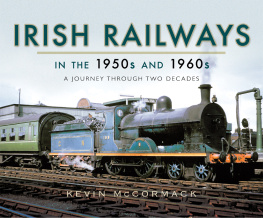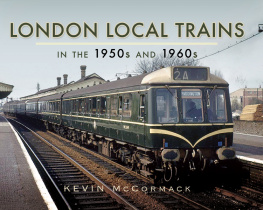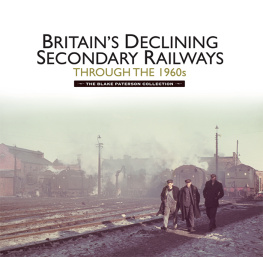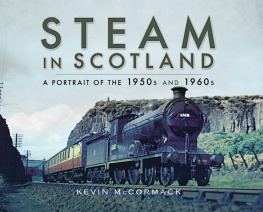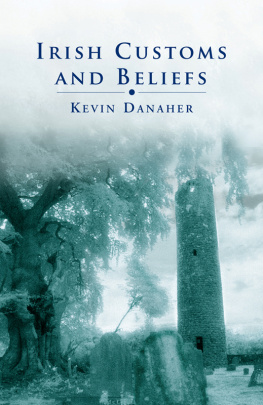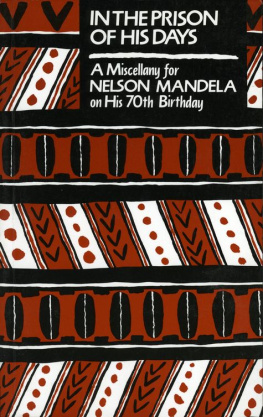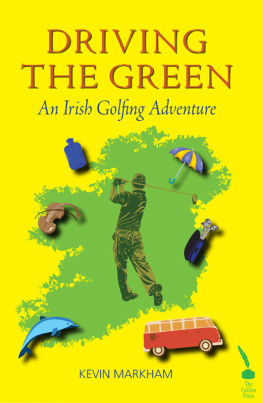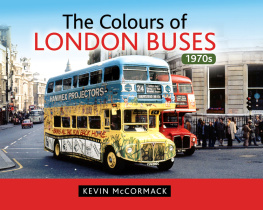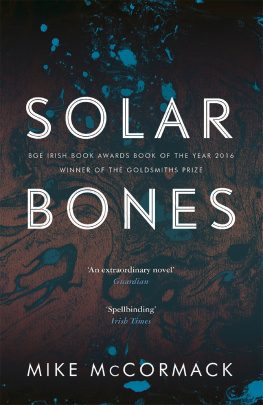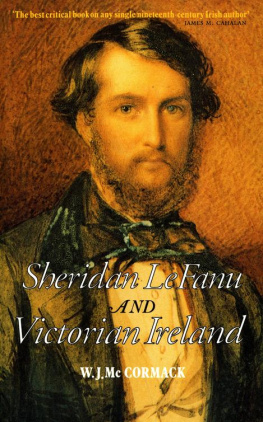McCormack Kevin - Irish Railways in the 1950s and 1960s
Here you can read online McCormack Kevin - Irish Railways in the 1950s and 1960s full text of the book (entire story) in english for free. Download pdf and epub, get meaning, cover and reviews about this ebook. year: 2017, publisher: Pen & Sword Books, genre: Religion. Description of the work, (preface) as well as reviews are available. Best literature library LitArk.com created for fans of good reading and offers a wide selection of genres:
Romance novel
Science fiction
Adventure
Detective
Science
History
Home and family
Prose
Art
Politics
Computer
Non-fiction
Religion
Business
Children
Humor
Choose a favorite category and find really read worthwhile books. Enjoy immersion in the world of imagination, feel the emotions of the characters or learn something new for yourself, make an fascinating discovery.
- Book:Irish Railways in the 1950s and 1960s
- Author:
- Publisher:Pen & Sword Books
- Genre:
- Year:2017
- Rating:4 / 5
- Favourites:Add to favourites
- Your mark:
- 80
- 1
- 2
- 3
- 4
- 5
Irish Railways in the 1950s and 1960s: summary, description and annotation
We offer to read an annotation, description, summary or preface (depends on what the author of the book "Irish Railways in the 1950s and 1960s" wrote himself). If you haven't found the necessary information about the book — write in the comments, we will try to find it.
Irish Railways in the 1950s and 1960s — read online for free the complete book (whole text) full work
Below is the text of the book, divided by pages. System saving the place of the last page read, allows you to conveniently read the book "Irish Railways in the 1950s and 1960s" online for free, without having to search again every time where you left off. Put a bookmark, and you can go to the page where you finished reading at any time.
Font size:
Interval:
Bookmark:



A JOURNEY THROUGH TWO DECADES
KEVIN M C CORMACK

First published in Great Britain in 2017 by
Pen & Sword Transport
An imprint of Pen & Sword Books Ltd
47 Church Street
Barnsley
South Yorkshire
S70 2AS
Copyright Kevin R. McCormack 2017
ISBN 9781473871984
eISBN 9781473872004
Mobi ISBN 9781473871991
The right of Kevin R. McCormack to be identified as the author of this work has been asserted by him in accordance with the Copyright, Designs and Patents Act 1988. All rights reserved. No part of this publication may be reproduced or transmitted in any form or by any means, electronic or mechanical, including photocopy, recording or any information storage and retrieval system, without the prior written permission of the publisher, nor by way of trade or otherwise shall it be lent, re-sold, hired out or otherwise circulated without the publishers prior consent in any form of binding or cover other than that in which it is published and without a similar condition including this condition being imposed on the subsequent purchaser.
Kevin R. McCormack 2017
Pen & Sword Books Ltd incorporates the imprints of Pen & Sword Archaeology, Atlas, Aviation, Battleground, Discovery, Family History, History, Maritime, Military, Naval, Politics, Railways, Select, Social History, Transport, True Crime, and Claymore Press, Frontline Books, Leo Cooper, Praetorian Press, Remember When, Seaforth Publishing and Wharncliffe.
For a complete list of Pen & Sword titles please contact
Pen & Sword Books Limited
47 Church Street, Barnsley, South Yorkshire, S70 2AS, England
E-mail: enquiries@pen-and-sword.co.uk
Website: www.pen-and-sword.co.uk
Front cover: Former GNR(I) U class 4-4-0 No.199, Lough Derg , prepares to depart from Dublin Amiens Street in July 1959. Built by Beyer, Peacock in April 1915, this engine was transferred on 1 October 1958 to CIE (the last letter of which is visible stencilled in white on the bufferbeam) upon the demise of the GNR Board and was withdrawn in November 1962. The locomotive received its name in April 1949. (Donald Nevin)
Title page: UTA W class 2-6-0 No.91, The Bush , simmers at Portadown shed, Co Armagh, in May 1962. The locomotive, which bears the name of a local river, was the second member of the W class (numbered 90-104) and was built at the Derby Works of the LMS, being delivered to the NCC in July 1933. It was scrapped in May 1965. (Jim Oatway)
T his album of colour photographs depicts the railway scene across Ireland during the final two full decades of steam operation. However, a review of this period would not be complete without the inclusion of a limited amount of non-steam traction, much of it relatively vintage in itself.
This book does not purport to cover the complicated history of Irish standard-gauge and narrow-gauge railways, which has already been fully covered in other publications. The purpose of this volume is to present more than 170 colour photographs that hopefully have never previously been seen in print. Indeed, it serves as a reminder of what many railway enthusiasts in Great Britain were missing across the Irish Sea, given their pre-occupation with the closure of lines under the Beeching Axe and the demise of steam on British Railways. The engines and rolling stock in Ireland were generally very British in appearance and part of the fascination was that most of the locomotives, even the main line ones, were comparatively small, with several having unusual wheel arrangements for their type; they looked dated (and in many cases were actually old).
A particular anomaly about Irish railways is the standard gauge, which is 5ft 3ins, as opposed to that in Great Britain which is 4ft 8ins, thereby requiring any stock transferred between Great Britain and Ireland to be regauged. The narrow gauge was generally 3ft. The Irish railway companies referred to the 5ft 3ins gauge as broad gauge, but I have taken the view that the only broad gauge in Ireland was the Ulster Railways short-lived 6ft 2ins gauge, so in this book I refer to the Irish gauge as standard gauge. In 1836 the Ulster Railway was authorised to build to a gauge of 6ft 2ins, and constructed their line from Belfast Great Victoria Street to Portadown to this gauge, whereas the Dublin and Drogheda Railway intended to use 5ft 2ins for economy reasons. Clearly, the line from Belfast to Dublin needed to have the same gauge to operate efficiently, so a compromise gauge of 5ft 3ins (hardly a compromise, some would say!) was decreed by Parliament and the Ulster Railway had to replace its broad gauge.
It is worth mentioning that the island of Ireland, consisting of thirty-two counties, used to be part of the United Kingdom. Partition occurred in 1921, when Northern Ireland was created, and a separate Irish Free State (now the Republic of Ireland) was established in the following year. The Free State controlled twenty-six counties, whereas the other six counties (Antrim, Armagh, Down, Fermanagh, Londonderry and Tyrone) remained part of the Union. Over the years there has been much restructuring of the railways on both sides of the border and the most relevant changes are summarised next.
In 1925 the various railways operating exclusively in the Free State were grouped into Great Southern Railways (GSR), and those operating entirely in Northern Ireland were already mostly integrated into a body known as the Northern Counties Committee (NCC) owned by Englands Midland Railway, which was superseded, following the railway grouping in 1923, by the London, Midland and Scottish Railway (LMS). GSR was taken over by the newly formed Coras Iompair Eireann (CIE) in 1945, and the Ulster Transport Authority (UTA), having taken control of the Belfast & County Down Railway (BCDR) in 1948, subsumed the NCC in 1949, following fifteen months of ownership by the British Transport Commission. For completeness, CIE ceased to be an operating company in 1987 and the Republics railways are now run by a subsidiary, Iarnrod Eireann (Irish Rail). UTAs railway interests were transferred to a new body, Northern Ireland Railways (NIR), in 1968 and now branded as Translink.
The partition of Ireland raised the question of how to deal with the various railways that straddled the border. Three of these are covered in this book: two standardgauge railways (the Great Northern Railway (Ireland) (GNR(I)) and the Sligo, Leitrim & Northern Counties Railway (SLNCR)) and one narrow-gauge (the County Donegal Railways Joint Committee (CDRJC)). The GNR was a favourite of railway enthusiasts for several reasons: it was a mainline operator whose services included the important BelfastDublin line, its passenger locomotives were painted sky-blue and it had two tram systems: the electric Hill of Howth Tramway in Co Dublin and the Fintona horse tram in Co Tyrone, Northern Ireland. These three railway companies were excluded from the nationalisation that occurred in Northern Ireland and the Republic in 1948 and 1950 respectively.
However, the GNR(I) suffered financial failure in the early 1950s due to increased road competition despite a modernisation programme; it announced that it was closing. This galvanised the two governments into action, culminating in de facto nationalisation by the creation of a joint governmental Board (the GNR Board) in 1953 to run the company. Outwardly, this allowed the GNR(I) to continue comparatively unchanged for a few more years until the Board was disbanded on 1 October 1958. At that point the routes and assets including the locomotives and rolling stock were divided between the UTA and CIE, although GNR(I) livery remained in evidence for a time. The division of the GNR(I) had, however, a significant impact on both sides of the border. CIE had all but abandoned steam in 1958 in favour of diesels and then found itself with an expanded rail network and some eighty extra steam locomotives, resulting in steam lingering on in the Republic until 1963. In Northern Ireland, which adopted an anti-railway approach at that time, several lines had been closed in the 1950s and the process continued with much of the inherited ex-GNR(I) network. Closure seemed to be favoured over modernisation, with the consequence that Northern Ireland was behind the Republic in terms of the steamto-diesel transition and did not withdraw its last steam locomotives until 1970.
Next pageFont size:
Interval:
Bookmark:
Similar books «Irish Railways in the 1950s and 1960s»
Look at similar books to Irish Railways in the 1950s and 1960s. We have selected literature similar in name and meaning in the hope of providing readers with more options to find new, interesting, not yet read works.
Discussion, reviews of the book Irish Railways in the 1950s and 1960s and just readers' own opinions. Leave your comments, write what you think about the work, its meaning or the main characters. Specify what exactly you liked and what you didn't like, and why you think so.

